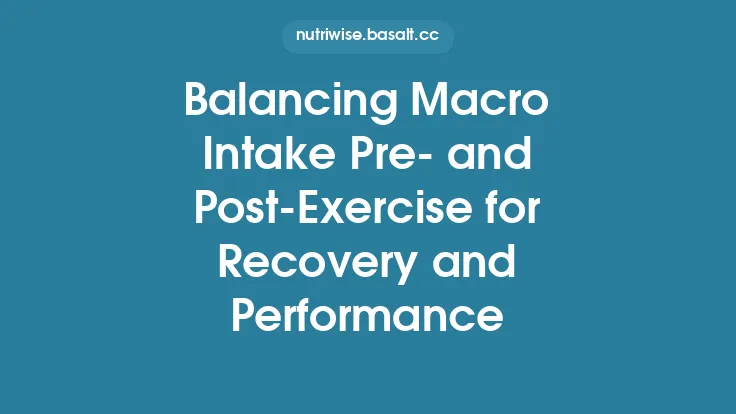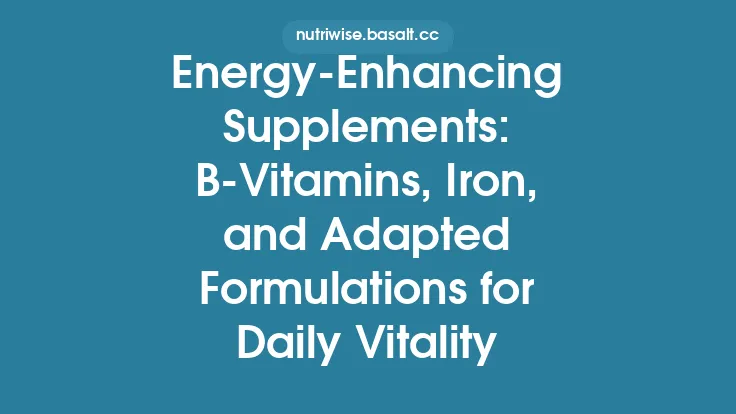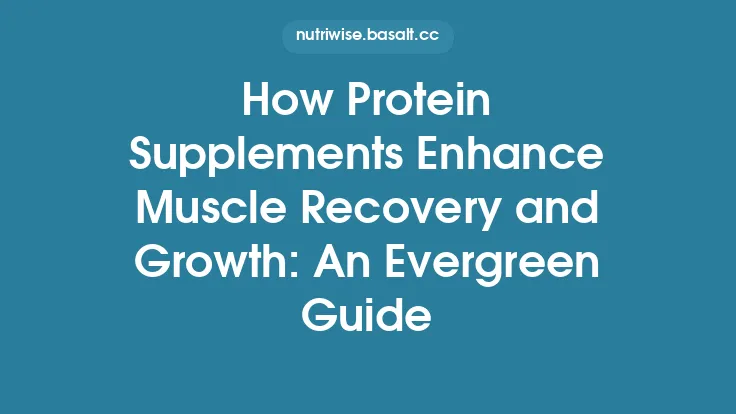Maintaining an active lifestyle well into later years brings a host of health benefits—improved cardiovascular function, better cognitive health, and enhanced mood, to name a few. Yet the physiological changes that accompany aging also alter how the body processes and utilizes nutrients. For older adults who regularly engage in endurance training, resistance work, or high‑intensity interval sessions, the balance between energy provision and tissue recovery becomes especially critical. Micronutrients—vitamins and minerals required in small amounts—play pivotal roles in cellular energy production, muscle protein synthesis, antioxidant defense, and bone remodeling. Proper planning ensures that the increased metabolic demands of exercise are met without compromising the body’s capacity to repair and adapt.
Understanding the Unique Nutritional Demands of Active Older Adults
Aging is accompanied by several physiological shifts that influence micronutrient needs:
| Age‑Related Change | Impact on Micronutrient Utilization |
|---|---|
| Reduced gastric acid secretion | Decreases absorption of minerals such as calcium, iron, and zinc. |
| Altered intestinal transport proteins | Affects bioavailability of B‑vitamins (e.g., B12) and fat‑soluble vitamins (A, D, E, K). |
| Sarcopenia (loss of muscle mass) | Increases reliance on nutrients that support protein synthesis (e.g., vitamin D, magnesium). |
| Diminished renal function | Modifies excretion of electrolytes and trace minerals, influencing optimal intake levels. |
| Changes in body composition | Higher fat mass can sequester fat‑soluble vitamins, reducing circulating levels. |
When regular physical activity is added to this backdrop, the body’s demand for certain micronutrients spikes. Exercise elevates metabolic rate, stimulates oxidative pathways, and creates micro‑trauma in muscle fibers—all processes that are heavily dependent on adequate micronutrient supply.
Key Micronutrients for Energy Metabolism
| Micronutrient | Primary Metabolic Role | Exercise‑Related Considerations |
|---|---|---|
| B‑Vitamins (B1, B2, B3, B5, B6, B7, B9, B12) | Act as co‑enzymes in glycolysis, the Krebs cycle, and oxidative phosphorylation. | Endurance activities increase carbohydrate turnover; B‑vitamin status correlates with perceived fatigue and VO₂max. |
| Magnesium | Cofactor for >300 enzymatic reactions, including ATP synthesis and muscle contraction. | Sweat losses can be significant; low magnesium impairs glycogen replenishment and may cause cramping. |
| Iron | Integral to hemoglobin and myoglobin; essential for oxygen transport and mitochondrial respiration. | Even mild iron deficiency can reduce aerobic capacity; older athletes often experience “sports anemia” due to hepcidin‑mediated sequestration. |
| Copper | Supports cytochrome c oxidase in the electron transport chain. | Adequate copper helps maintain efficient oxidative metabolism, especially when carbohydrate intake is moderate. |
| Coenzyme Q10 (Ubiquinone) | Electron carrier within mitochondria; also functions as an antioxidant. | Supplementation has been shown to improve exercise tolerance in older adults with reduced endogenous synthesis. |
Practical tip: Pair carbohydrate‑rich meals with a source of B‑vitamins (e.g., whole grains, legumes, fortified cereals) and a modest amount of magnesium‑rich foods (nuts, seeds, leafy greens) within the post‑exercise window to accelerate glycogen restoration.
Micronutrients Supporting Muscle Recovery and Repair
- Vitamin D
- Function: Enhances calcium absorption, modulates muscle protein synthesis via the mTOR pathway, and influences satellite cell activity.
- Evidence: Older adults with serum 25‑OH‑D levels >30 ng/mL exhibit greater gains in lean mass after resistance training compared to deficient peers.
- Sources: Fatty fish, fortified dairy, UV‑B exposure; supplementation of 1,000–2,000 IU/day is often required to achieve optimal status.
- Zinc
- Function: Crucial for DNA synthesis, cell division, and the activity of metalloproteinases involved in extracellular matrix remodeling.
- Exercise Link: Zinc deficiency blunts the anabolic response to protein intake and may prolong DOMS (delayed‑onset muscle soreness).
- Sources: Oysters, red meat, pumpkin seeds; consider a 15–30 mg/day supplement if dietary intake is low.
- Selenium
- Function: Component of glutathione peroxidase, protecting muscle cells from oxidative damage during intense bouts.
- Research: Adequate selenium status is associated with reduced markers of muscle fatigue post‑exercise.
- Sources: Brazil nuts (1–2 nuts provide >100 µg), fish, whole grains.
- Vitamin C & Vitamin E
- Function: Scavenge free radicals generated during high‑intensity activity, preserving membrane integrity.
- Timing: Consuming 500 mg vitamin C and 15 mg vitamin E within 30 minutes post‑exercise can attenuate oxidative stress without impairing training adaptations.
- Caution: Excessive antioxidant supplementation may blunt beneficial signaling pathways; aim for food‑based intake when possible.
Antioxidants and Inflammation Control
Chronic low‑grade inflammation (“inflammaging”) is a hallmark of aging and can be exacerbated by intense training. Micronutrients that modulate inflammatory pathways are therefore essential:
- Omega‑3 Fatty Acids (EPA/DHA) – Though technically macronutrients, they act synergistically with micronutrients like vitamin D to reduce cytokine production (IL‑6, TNF‑α).
- Polyphenols (e.g., quercetin, curcumin) – Provide additional antioxidant capacity and may improve mitochondrial biogenesis.
- Magnesium – Low levels are linked to elevated CRP (C‑reactive protein); ensuring adequate intake helps keep systemic inflammation in check.
Implementation: Incorporate fatty fish twice weekly, sprinkle berries and leafy greens into meals, and consider a low‑dose curcumin supplement (≈500 mg with piperine) on heavy training days.
Bone Health and Micronutrient Synergy for Active Seniors
While the broader senior population focuses on bone preservation, active older adults require a nuanced approach that balances strength, flexibility, and impact loading:
- Calcium + Vitamin D – The classic duo; vitamin D enhances calcium absorption, while calcium provides the mineral matrix for bone.
- Vitamin K2 (MK‑7) – Directs calcium to the skeleton and away from soft tissues; improves bone mineral density when combined with vitamin D.
- Boron – Facilitates the metabolism of calcium, magnesium, and vitamin D; modest supplementation (3 mg/day) can support bone turnover markers.
- Silicon (as orthosilicic acid) – Promotes collagen synthesis, essential for the organic component of bone and tendons.
Training Integration: Weight‑bearing and resistance exercises stimulate osteogenic responses; ensuring these micronutrients are present maximizes the adaptive signal.
Hydration and Electrolyte Balance
Sweat losses during prolonged activity can deplete electrolytes, especially sodium, potassium, and chloride. Older adults often have a blunted thirst response, making proactive fluid management vital.
- Sodium – Primary extracellular cation; essential for nerve impulse transmission and muscle contraction. Aim for 300–600 mg sodium per hour of moderate to intense exercise, adjusted for climate and individual sweat rate.
- Potassium – Intracellular cation; supports cellular repolarization and glycogen synthesis. Include potassium‑rich foods (bananas, potatoes, avocados) in post‑exercise meals.
- Magnesium & Calcium – Minor contributors to sweat electrolyte loss but important for preventing cramping; a balanced electrolyte drink containing 30–50 mg magnesium per liter can be beneficial.
Practical Strategies for Meeting Micronutrient Needs
- Food First, Supplement Second – Prioritize whole foods that naturally contain the target micronutrients. A typical day might include oatmeal with fortified soy milk (B‑vitamins, calcium, vitamin D), a salmon salad with mixed greens and pumpkin seeds (vitamin D, omega‑3, zinc, magnesium), and a snack of Greek yogurt with berries (calcium, vitamin C, selenium).
- Timing Around Workouts
- Pre‑Exercise (30–60 min): Small carbohydrate snack with B‑vitamins (e.g., whole‑grain toast with nut butter).
- During Exercise (>60 min): Electrolyte‑enhanced water or a low‑calorie sports drink containing sodium, potassium, and magnesium.
- Post‑Exercise (within 30 min): Protein‑rich meal (20–30 g) paired with vitamin D‑fortified dairy or a plant‑based alternative, plus antioxidant‑rich fruit.
- Seasonal Adjustments – In winter, sunlight exposure drops, often necessitating higher vitamin D supplementation (up to 2,000 IU/day). In summer, increased sweating may require more electrolytes.
- Cooking Techniques – Light steaming preserves water‑soluble B‑vitamins; avoid over‑cooking leafy greens to maintain vitamin K content.
Supplementation Considerations and Safety
| Micronutrient | Typical Supplemental Dose for Active Older Adults | Upper Safe Limit* | Notes |
|---|---|---|---|
| Vitamin D3 | 1,000–2,000 IU/day (adjust based on serum 25‑OH‑D) | 4,000 IU/day | Monitor serum levels every 6–12 months. |
| Magnesium (citrate) | 200–400 mg/day | 350 mg (dietary) + 350 mg (supplement) | Split doses to improve absorption; watch for diarrhea. |
| Zinc (gluconate) | 15–30 mg/day | 40 mg/day | Avoid long‑term high doses; can interfere with copper. |
| Vitamin B12 (methylcobalamin) | 500–1,000 µg/day (if deficient) | No established UL | Sublingual or injectable forms bypass absorption issues. |
| CoQ10 | 100–200 mg/day | No UL | May interact with anticoagulants; monitor INR if on warfarin. |
| Selenium | 100–200 µg/day | 400 µg/day | Excess can cause selenosis; obtain from diet first. |
*Upper limits are based on Institute of Medicine recommendations and may vary by country.
Key safety points
- Medication Interactions: Calcium can reduce absorption of certain antibiotics (e.g., tetracyclines); iron supplements may interfere with levothyroxine. Space dosing by at least 2 hours.
- Renal Considerations: High potassium or magnesium intake may be contraindicated in advanced chronic kidney disease; consult a healthcare professional.
- Testing: Periodic blood panels (CBC, ferritin, vitamin D, B12, electrolytes) help tailor supplementation and avoid toxicity.
Sample Meal Plan for a Training Day
| Time | Meal | Micronutrient Highlights |
|---|---|---|
| 07:00 | Breakfast: Oatmeal cooked in fortified soy milk, topped with sliced banana, chia seeds, and a handful of blueberries. | B‑vitamins (B1, B2, B6), magnesium, potassium, vitamin D, antioxidants (vit C, anthocyanins). |
| 09:30 | Pre‑Workout Snack: Whole‑grain toast with almond butter and a drizzle of honey. | B‑vitamins, magnesium, zinc, healthy fats. |
| 12:00 | Post‑Workout Lunch: Grilled salmon (150 g) with quinoa, roasted sweet potatoes, and a mixed‑leaf salad (spinach, kale, bell peppers) dressed with olive oil and lemon. | Vitamin D, omega‑3, selenium, iron (from quinoa), vitamin K, potassium, magnesium. |
| 15:00 | Afternoon Snack: Greek yogurt (plain) with a sprinkle of crushed walnuts and a few dried apricots. | Calcium, vitamin B12, zinc, copper, vitamin E. |
| 18:30 | Dinner: Stir‑fried tofu with broccoli, bok choy, and bell peppers in a ginger‑garlic sauce, served over brown rice. | Calcium (from tofu), vitamin C, magnesium, iron (non‑heme), B‑vitamins, selenium. |
| 21:00 | Evening Recovery Drink: Warm milk (or fortified plant milk) with a scoop of whey protein, a pinch of cinnamon, and 500 mg of vitamin C powder. | Protein for repair, calcium, vitamin D (if fortified), vitamin C. |
Hydration: 2–3 L of water throughout the day, supplemented with an electrolyte drink during the 90‑minute training session.
Monitoring and Adjusting Micronutrient Intake
- Baseline Assessment – Conduct a comprehensive blood panel before initiating a new training regimen. Include CBC, ferritin, serum 25‑OH‑D, B12, folate, electrolytes, and inflammatory markers (CRP).
- Performance Metrics – Track perceived exertion, recovery time, and any occurrence of cramping or fatigue. Sudden changes may signal a micronutrient imbalance.
- Periodic Re‑evaluation – Every 3–6 months, repeat labs and adjust dietary or supplemental strategies accordingly.
- Feedback Loop – Use a simple log (e.g., spreadsheet or app) to record food intake, supplement doses, training load, and symptoms. Patterns often reveal deficiencies before they manifest clinically.
Bottom Line
Active older adults occupy a unique nutritional niche where the demands of exercise intersect with age‑related physiological changes. By focusing on the micronutrients that drive energy metabolism, muscle repair, antioxidant protection, and bone integrity, and by aligning intake with training schedules, seniors can sustain high performance, accelerate recovery, and preserve overall health. A balanced approach—prioritizing nutrient‑dense whole foods, judicious supplementation, and regular monitoring—offers a practical roadmap for thriving in the golden years of athletic pursuit.





